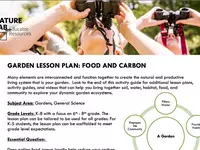Garden Lesson Plan: Food and Carbon
https://www.nature.org/content/dam/tnc/nature/en/documents/nature-lab-lesson-plans/NL.FoodandCarbonTeacherGuideK8Updated.2023.pdf
https://www.nature.org/content/dam/tnc/nature/en/documents/nature-lab-lesson-plans/NL.FoodandCarbonTeacherGuideK8Updated.2023.pdf
Nature Lab Educator Resources
This lesson evaluates our food production system and introduces students to the dynamic life-cycle of food including from start to finish encompassing the production, transportation, and consumption cycle of individual food items. Students will explore the practice of growing one's own food or obtaining food from locally produced sources and its impact on the environment through Carbon Dioxide reduction.
This learning activity takes seven 45 minute sessions.
Learn more about Teaching Climate Literacy and Energy Awareness»Grade Level
Online Readiness
Topics
Energy Literacy
This Activity builds on the following concepts of Energy Literacy.
Click a topic below for supporting information, teaching ideas, and sample activities.
Notes From Our Reviewers
The CLEAN collection is hand-picked and rigorously reviewed for scientific accuracy and classroom effectiveness.
Read what our review team had to say about this resource below or learn more about
how CLEAN reviews teaching materials
Teaching Tips | Science | Pedagogy |
Technical Details
Teaching Tips
- Comparison of locally produced and agriculturally produced vegetables and other produce's carbon emissions is a fun long-term project, especially if you have access to a garden.
- Students may need some prior knowledge of vocabulary terms like carbon dioxide, fossil fuels, and ecosystem services to more deeply understand the videos.
About the Content
- In this activity, students find the difference between the amount of carbon emissions from agricultural produce and garden-grown produce.
- This comparison between school gardens and commercial farming highlights the benefits of locally produced fruits and vegetables for offsetting carbon emissions.
- The background materials are extensive, but educators will have to do some of their own research to find the distance travelled for the specific type of produce they are comparing.
- Passed initial science review – expert science review pending.
About the Pedagogy
- This lesson requires access to an established garden, ideally a school garden which could be a big limitation for some schools/programs.
- The lesson provides a flow from start to finish with clear objectives, links to videos, handouts, ways to reflect, and extensions.
- The lesson does not discuss the cost of local food vs the cost of mass produced/large scale agriculture which is a major influencer that affects our consumption/decisions.
- Next Generation Science Standards and Learning Outcomes are clearly defined and listed, including comprehension, application, analysis, synthesis and evaluation.
- The lesson is sequenced so that students have the opportunity to explore, research, harvest, eat, and compare data - which should lead to an engaging lesson. Learners will have ample opportunities to find ways to explore and find ways to be academically successful.
- This resource engages students in using scientific data.
See other data-rich activities








